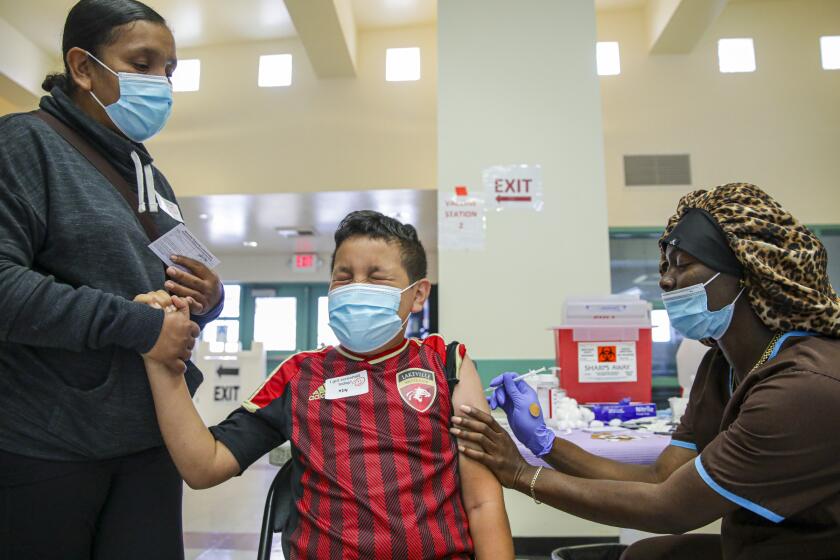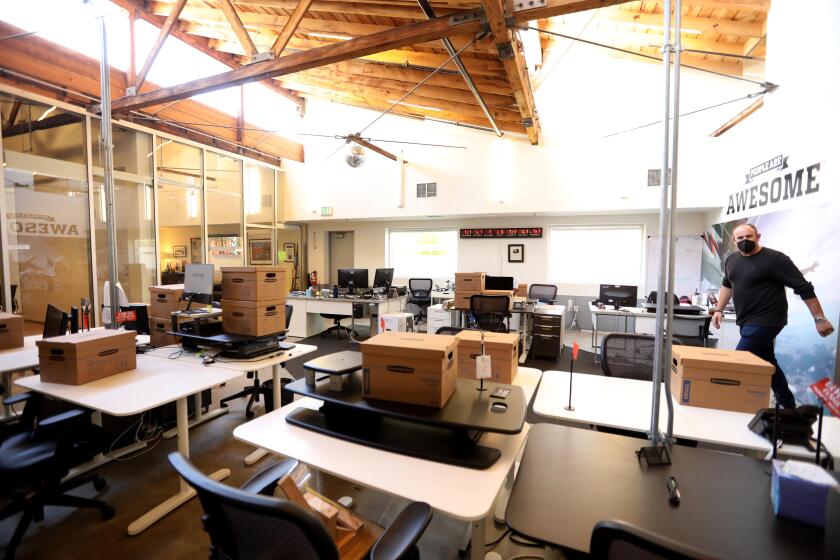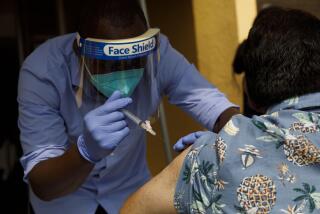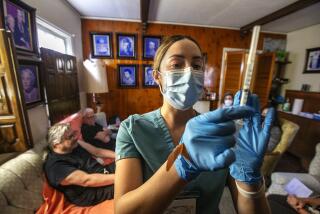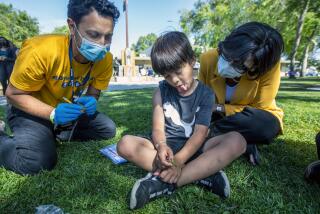Column: They are L.A.âs last hope for converting scores of COVID-19 vaccine skeptics
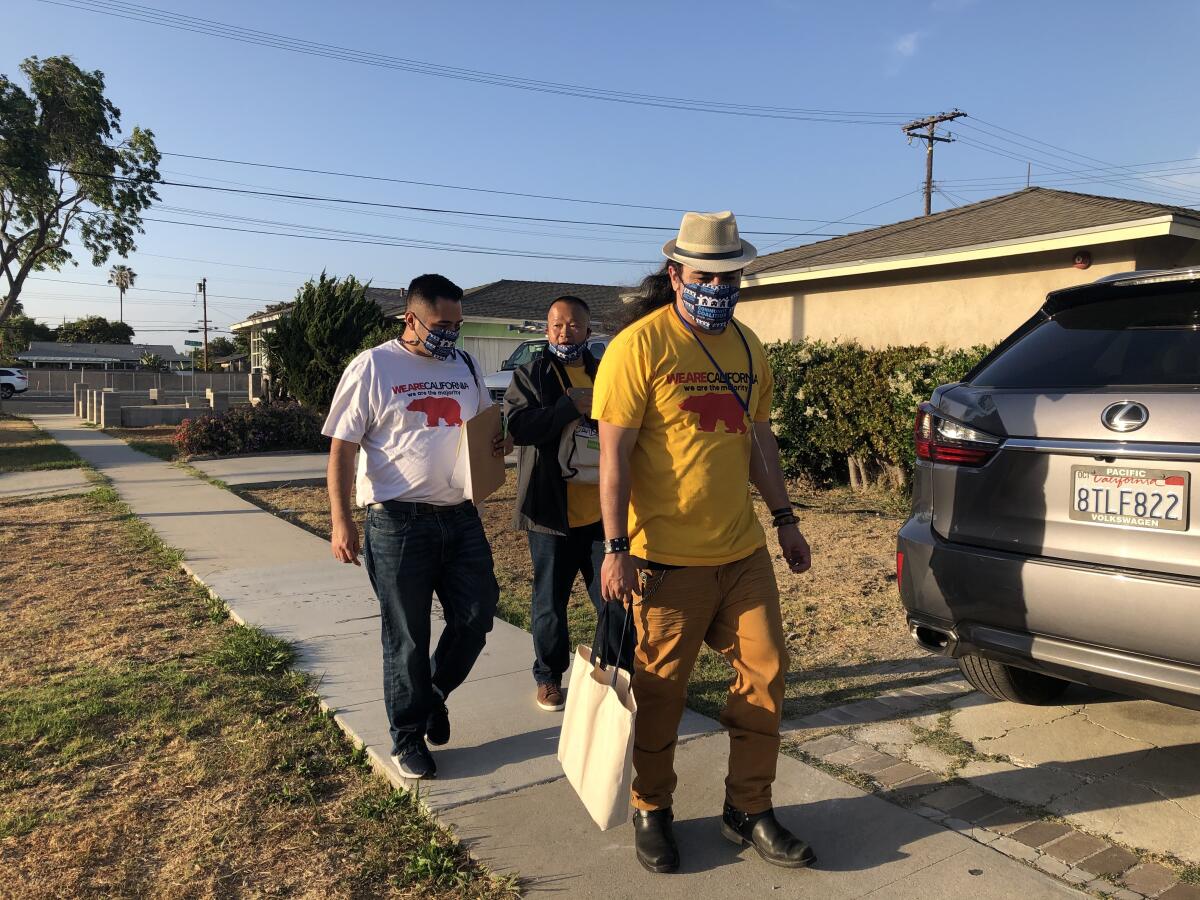
Douglas Jessop wasnât getting anywhere.
For the past 15 minutes, the canvasser with Community Coalition had been standing in a driveway in South L.A., listening to Myra Trahan explain why she hadnât gotten around to getting vaccinated for COVID-19. Mostly, the 19-year-old college student told him, itâs because she hadnât had time to do her own research.
Jessop nodded and finally asked: âWhat would satisfy you enough to be like, âOK, Iâll go get itâ?â
Trahan thought for a moment.
âIâm not really sure,â she said. âLike I donât know whatâs really stopping me and I donât know what really could push me to get to it. I just need to know the long-term effects. I need to know if this is something I need to get every month, every two months, every year? Or is it just like a one-time shot type of thing?â
Now Jessop was stumped.
âWhat we could do for you is we could get your number, we can take it down and have a follow-up team call you,â he said. âWanna do that?â
Trahan nodded. That alone was progress.
::
For months now, Iâve been writing about Californiaâs fervent, but mostly failed efforts to distribute COVID-19 vaccines equitably. Increasingly, though, as the state edges back to normal, my inbox has been filling up with annoyed missives like this one from a reader named Steve.
âIt is easy for everyone to get a vaccine,â he wrote. âQuit your pandering to the lazy people that wonât make the effort. People need to take personal responsibility.â
I hate to admit it, but I can almost understand the thinking.
At this late stage of the pandemic, most people in California have managed to get vaccinated. To be precise, roughly two thirds of everyone who is eligible has received at least one dose and nearly half are fully vaccinated.
Even as California heads toward reopening and abandoning face masks, wide disparities still exist in the distribution of COVID-19 vaccines.
Vaccines are plentiful, yet disparities remain. This is especially true in Los Angeles County, where only 34% of Black residents and 42% of Latino residents ages 16 to 64 have received at least one dose, compared to 67% of Asian American and 57% of white residents.
âWe do need to double down on our efforts to reduce any barriers to vaccination in hard-hit communities,â L.A. County Public Health Director Barbara Ferrer said this week. âEverywhere that there are lots of people that are not vaccinated â that are intermingling without any distancing or mask wearing â youâve still got opportunities for there to be outbreaks.â
Who are these holdouts? Why are they holding out? And most importantly, what will get them to stop holding out?
These questions arenât just academic for me anymore.
A few days ago, I found out my uncle and aunt â both of whom are pushing 80 years old â and a handful of cousins havenât gotten vaccinated and have no plans to do so. Like Trahan, they donât really have a reason why they wonât, and so reasoning with them has proved futile.
Get the latest from Erika D. Smith
Commentary on people, politics and the quest for a more equitable California.
You may occasionally receive promotional content from the Los Angeles Times.
Is there hope?
I wanted to know, so on Thursday, I joined Jessop and fellow canvassers David Nguyen and Pierre Sandoval as they knocked on doors in search of the unvaccinated in a working-class neighborhood of well-kept homes and impeccable yards in Gardena.
Our journey started in nearby Helen Keller Park, where Linda Gomez-Evans, the civic engagement specialist for Community Coalition, doled out the eveningâs assignments.
For about two months, she has been deploying both paid and volunteer outreach workers to canvass the overwhelmingly Black and Latino neighborhoods of South Los Angeles. The goal, she said, is to knock on the door of every home and apartment across 15 ZIP Codes by June 30 â roughly two weeks after California is set to fully reopen its economy and allow vaccinated people to ditch our masks.
So far, the canvassers are approaching the halfway mark. They have crossed nearly 11,000 residences off the list and set up 325 vaccination appointments in the process.
âWe try to hit the areas that donât have vaccination sites,â Gomez-Evans said, âor the areas that do have vaccination sites and that the community is not aware of it.â
But even more important than picking the right neighborhoods is picking the right messengers. The canvassers arenât doctors or healthcare workers. Instead they are, overwhelmingly, people of color who grew up in South L.A. Many have been incarcerated and some homeless.
âItâs just knowing itâs not coming from the government,â she said. âThis is coming from our community.â
::
Nguyen has only been canvassing for a few days, but he said heâs already heard it all.
âPeople tell me thereâs microchips in the vaccine,â he said. âBut at the same time, thereâs a lot of good people that are encouraging us to continue to do the work to better the community.â
Some people canât take off work long enough to get vaccinated or deal with the side effects. And some say they donât have a way to get to an appointment. But most of the time, Jessop said â and Nguyen and Sandoval agreed â people are just afraid.
Come June 15, businesses in California can open their doors without COVID-19 constraints and fully vaccinated people can go mask-free in most situations.
âWhen you are coming from these impoverished communities, youâre used to being left out. Youâre used to being screwed over. Youâre used to all of that type of treatment,â Jessop said. âSo if all of a sudden, governmentâs coming through, like, âweâre here to give you a vaccine,â it freaks them out. So, Iâm like, âYo, Iâm not out here with the government, bro.ââ
Indeed, more than anything else, all three men clearly had no particular love for government of any stripe. And that clearly helped them connect with both vaccinated and unvaccinated residents â a number of whom acknowledged they had seen little reason in their lives to trust or rely on government, its systems or its people, including public health officials.
Nguyen, who is on parole and passionate about helping a community he once hurt, was able to strike up conversations with residents who had also had run-ins with the criminal justice system â or whose relatives had.
Same with Jessop, who spent years behind bars and then was homeless for a time, fighting with government entities to get housing. And Sandoval, who grew up ducking drive-by shootings, is on the verge of losing his housing.
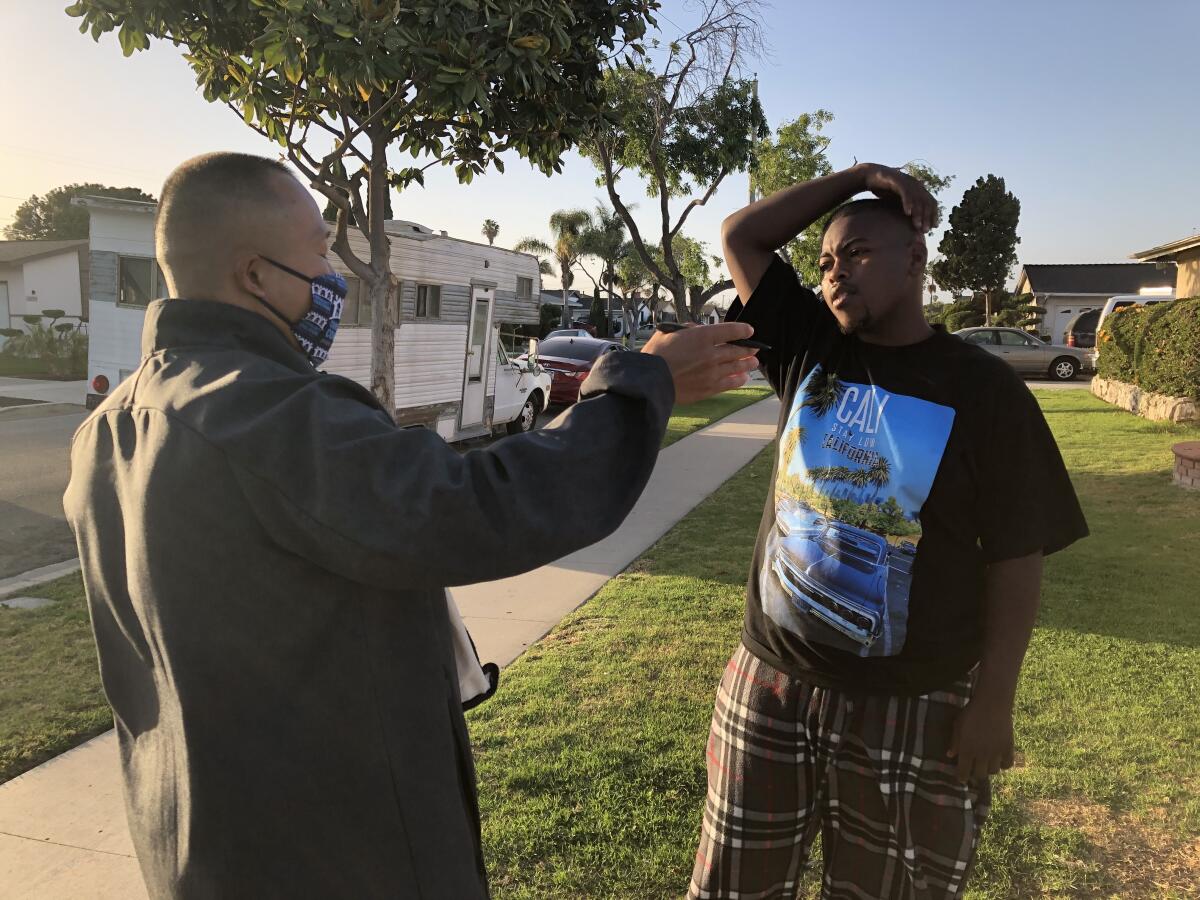
After leaving Trahanâs house, the three canvassers stopped on the sidewalk to take stock of who they had engaged so far. Most residents they had talked to in the neighborhood said they had already been vaccinated. The few who hadnât and wanted an appointment would soon be contacted by a follow-up team and be directed to a nearby vaccination site.
Sandoval looked at his iPhone, swiping at a map to see how many homes were left on the eveningâs list. Meanwhile, Nguyen and Jessop crossed the street and starting ringing doorbells, waving into the many Ring home security cameras that lined the block and sometimes flinching at the sound of big barking dogs.
One man who answered his door was Dave Sherman. Nguyen spent several minutes persuading him to make an appointment to get vaccinated.
Sherman had tried to get the jab a few months ago, but was rejected because he hadnât yet turned 65. After his birthday, he went back, but the line was so long that he just drove away and hadnât returned. Meanwhile, no one else in his family â his wife, children, siblings, nieces or nephews â has gotten vaccinated either.
âTheyâre pretty much suspicious. They just donât want it. Nobody wants to be the great [government] experiment again,â Sherman told me. âIf I get it and everything is OK, I think theyâll follow suit.â
And after months of feeling he didnât need to get vaccinated, Jaylen Nelson also agreed to make an appointment. The canvassers caught up with him not long after his grandmother had left the house to get a COVID-19 test.
âThey say I interact with too many people all day,â said Nelson, who works at an auction, buying and selling cars.
He just didnât feel like he needed the extra protection because he always wears a mask at work and never got sick. But looking at Nguyen, Jessop and Sandoval, he changed his mind.
âI guess Iâll take one and make G-mom feel good,â Nelson joked. âYou want me to give to you my number?â
More to Read
Get the latest from Erika D. Smith
Commentary on people, politics and the quest for a more equitable California.
You may occasionally receive promotional content from the Los Angeles Times.
